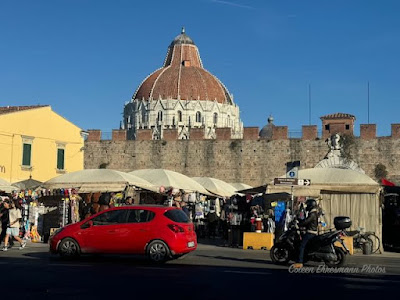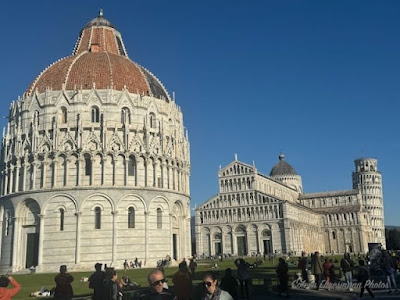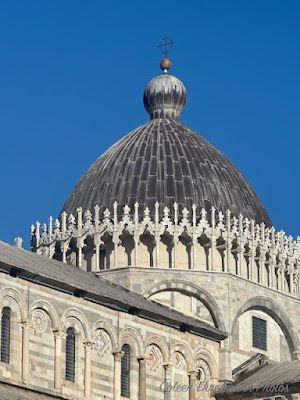The Leaning Tower of Pisa has always held a bit of intrigue for me. It is one of those world landmarks I always wanted to visit. That happened on this trip. We took the train from Florence to Pisa. Our visit was a short one because of train times and cruise departure. There was no time to buy tickets to explore the buildings on the inside.
stalls outside the fortification walls selling all kinds of trinkets
entrance to Cathedral Square and the first glimpse of
the Leaning Tower
The Leaning Tower of Pisa, or simply the Tower of Pisa, is the campanile, or freestanding bell tower, of Pisa Cathedral. It is known for its nearly four-degree lean, the result of an unstable foundation. ~ Wikipedia
the Pisa Cathedral
the Baptistry
The Baptistry was dedicated to St. John the Baptist. It is the largest Baptistry in the world and is known for is amazing acoustics.
the Bell Tower
Construction of the tower occurred in three stages over 199 years. In August 1173 construction began on the white marble campanile but as the second and third story were added, it began to lean due to the unstable subsoil. Construction was halted from 1178 to 1272. The seventh floor was completed in 1319 and the bell-chamber was finally added in 1372. The tower has 7 bells, one for each note of the musical major scale. The tower has a height of 183 feet 3 inches. (People were walking around the bell tower. There are 251 steps on a spiral staircase. It could take as much as 30 minutes to climb.)
The tower was closed to the public from January 1990 and reopened in 2001. The bells were removed during the stabilization effort. Soil was removed and replaced but the tilt of the tower was to remain. The tower was also cleaned and repaired, due to corrosion and blackening from exposure to wind and rain. The bells were put back in place.
the cemetery or Camposato is in the background
The Cathedral construction began in 1063 and was completed in 1092. The Pisa Cathedral is one of the largest in Europe. Pope Gregory VIII is buried there.
In the 16th century, a 19-year-old Galileo made a particularly important discovery inside Pisa Cathedral. The movement of the cathedral’s chandelier inspired his theory of isochronism of small oscillations. The complex further contributed to the history of science by acting as a forum for some of his experiments. ~ Pisa Cathedral Complex
The exterior is particularly famous, with exquisite marble Islamic-style arches being so well-worked that they almost look like embroidery. One of the most famous pieces inside is Giovanni Pisano’s masterpiece marble pulpit, as well as Byzantine-style mosaics, a golden ceiling, and 68 monolithic columns brought from Sardinia. ~ Pisa Cathedral Complex
In its heyday (roughly between 1000-1300 AD), Pisa was a maritime power with strong dominance over the sea, trading into the Mediterranean and even as far as Syria. In fact, it even gained control over Sicily and Corsica, and rivaled Genoa in the north. The construction of the Square of Miracles (or Piazza dei Miracoli in Italian), a patch that’s partly paved and grassed, was a testament to its power and prosperity. ~ Leaning Tower of Pisa
statue on the fortification wall

~ photo from Wikipedia to show the Cathedral Square
We rode the trains in Spain and in Italy. OFD got us to every location and back again. Sometimes we needed a bit of help purchasing the tickets as there were options we did not understand. Usually there was a very understanding, English speaking attendant to help.
The train we took from Pisa to Liverno was one of the nicest. The trains were clean and comfortable.
There were options for 4 seats together facing each other. It was a nice way to see the countryside as we traveled from city to city.
Sunset in Liverno at 5:01 pm from the balcony of our cruise ship stateroom. Goodbye Italy.














No comments:
Post a Comment
Thanks for your comments!